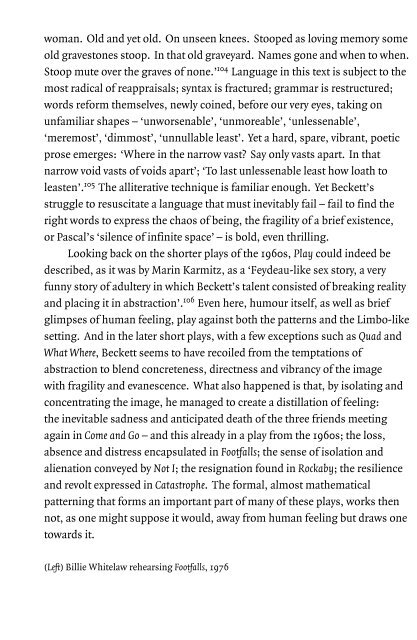You also want an ePaper? Increase the reach of your titles
YUMPU automatically turns print PDFs into web optimized ePapers that Google loves.
woman. Old and yet old. On unseen knees. Stooped as loving memory some<br />
old gravestones stoop. In that old graveyard. Names gone and when to when.<br />
Stoop mute over the graves <strong>of</strong> none.’ 104 Language in this text is subject to the<br />
most radical <strong>of</strong> reappraisals; syntax is fractured; grammar is restructured;<br />
words reform themselves, newly coined, before our very eyes, taking on<br />
unfamiliar shapes – ‘unworsenable’, ‘unmoreable’, ‘unlessenable’,<br />
‘meremost’, ‘dimmost’, ‘unnullable least’. Yet a hard, spare, vibrant, poetic<br />
prose emerges: ‘Where in the narrow vast? Say only vasts apart. In that<br />
narrow void vasts <strong>of</strong> voids apart’; ‘To last unlessenable least how loath to<br />
leasten’. 105 The alliterative technique is familiar enough. Yet <strong>Beckett</strong>’s<br />
struggle to resuscitate a language that must inevitably fail – fail to find the<br />
right words to express the chaos <strong>of</strong> being, the fragility <strong>of</strong> a brief existence,<br />
or Pascal’s ‘silence <strong>of</strong> infinite space’ – is bold, even thrilling.<br />
Looking back on the shorter plays <strong>of</strong> the 1960s, Play could indeed be<br />
described, as it was by Marin Karmitz, as a ‘Feydeau-like sex story, a very<br />
funny story <strong>of</strong> adultery in which <strong>Beckett</strong>’s talent consisted <strong>of</strong> breaking reality<br />
and placing it in abstraction’. 106 Even here, humour itself, as well as brief<br />
glimpses <strong>of</strong> human feeling, play against both the patterns and the Limbo-like<br />
setting. And in the later short plays, with a few exceptions such as Quad and<br />
What Where, <strong>Beckett</strong> seems to have recoiled from the temptations <strong>of</strong><br />
abstraction to blend concreteness, directness and vibrancy <strong>of</strong> the image<br />
with fragility and evanescence. What also happened is that, by isolating and<br />
concentrating the image, he managed to create a distillation <strong>of</strong> feeling:<br />
the inevitable sadness and anticipated death <strong>of</strong> the three friends meeting<br />
again in Come and Go – and this already in a play from the 1960s; the loss,<br />
absence and distress encapsulated in Footfalls; the sense <strong>of</strong> isolation and<br />
alienation conveyed by Not I; the resignation found in Rockaby; the resilience<br />
and revolt expressed in Catastrophe. The formal, almost mathematical<br />
patterning that forms an important part <strong>of</strong> many <strong>of</strong> these plays, works then<br />
not, as one might suppose it would, away from human feeling but draws one<br />
towards it.<br />
(Left) Billie Whitelaw rehearsing Footfalls, 1976<br />
As someone who (to my acute embarrassment) found himself bursting<br />
into tears at a dress rehearsal <strong>of</strong> Footfalls, I find the notion <strong>of</strong> <strong>Beckett</strong> as an<br />
arid, inhuman formalist extremely difficult to accept. It is, moreover,<br />
precisely this particular blend <strong>of</strong> reduction, concentration and distillation<br />
with the intricate patterning and repetition <strong>of</strong> words, gestures and<br />
movements that has made <strong>Beckett</strong> into such a major influence on modern<br />
painters and on video and installation artists.<br />
IMAGES OF BECKETT 95


